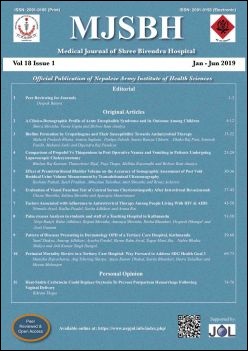Pattern of Diseases Presenting in Dermatology OPD of a Tertiary Care Hospital, Kathmandu
Keywords:
dermatoses, infectious, noninfectious, seasons, variation, OPDAbstract
Introduction: Dermatological conditions make up a significant burden of hospital visits. This study aims to calculate the prevalence of different dermatological conditions among OPD visits in a tertiary care hospital in Kathmandu, and describe the variation of those conditions with demographic variables and seasons.
Methods: This study was performed retrospectively using the data collected in the OPD register of a tertiary level hospital from 14th April 2017 to 13th April 2018. Analysis was conducted using MS Excel 2016 and Statistical Package for the Social Sciences (SPSS) v25.
Results: A total number of 24,332 OPD visits were recorded in the year. 54.3% of the visits were made by males and 45.7% by females and most common age group seeking dermatological consultation was 25 to 34 years. Noninfectious dermatoses were more common than infections. The most common noninfectious dermatoses were dermatitis/eczema, urticaria, angioedema and hypersensitivity, and pigmentary disorders in descending order of frequency. The common infectious dermatoses in decreasing order of frequency were fungal, viral, and parasitic/protozoal conditions. The infectious dermatoses were found to be significantly higher in males (p<0.05) while pigmentary disorders, urticaria and angioedema, autoimmune cutaneous disorders, disorders of pilosebaceous units and xerosis were significantly higher in females (p<0.05). Bacterial, fungal and viral infections, eczemas, urticarial/angioedema, papulosquamous disorders, xerosis, neoplasms and vasculitis showed significant seasonal variation.
Conclusions: Eczemas and fungal infections are the most common dermatoses. Infectious dermatoses and several non-infectious dermatoses vary significantly with seasons.
Downloads
Downloads
Published
How to Cite
Issue
Section
License
This license enables reusers to distribute, remix, adapt, and build upon the material in any medium or format for noncommercial purposes only, and only so long as attribution is given to the creator.




